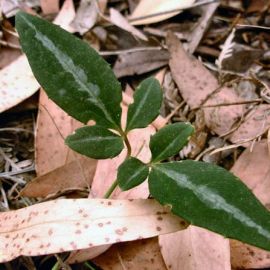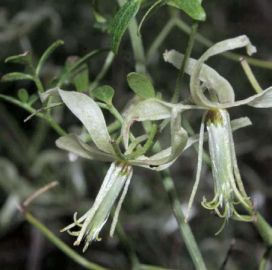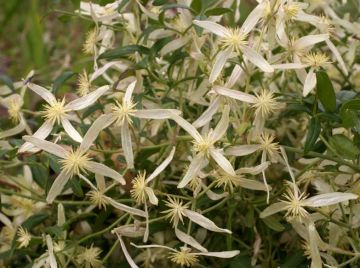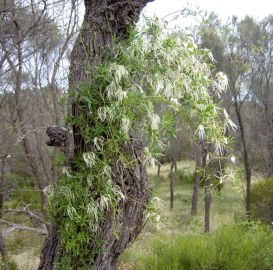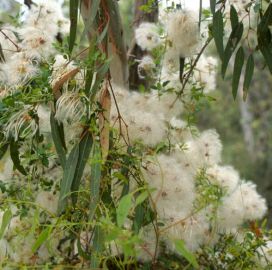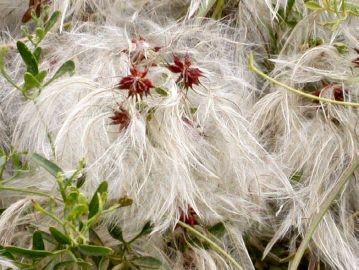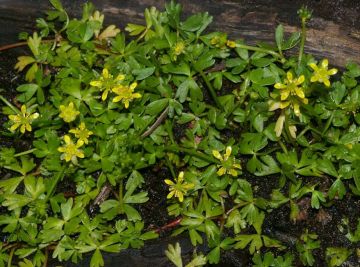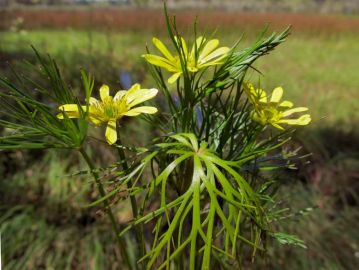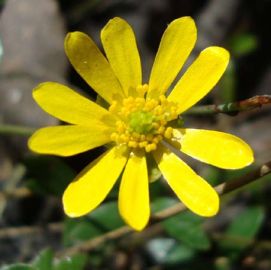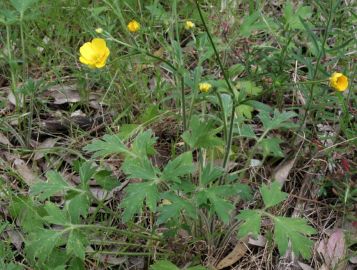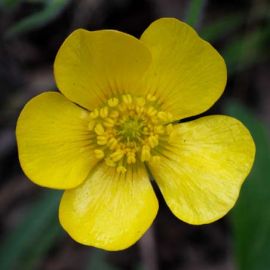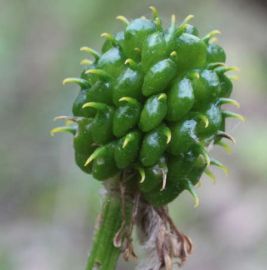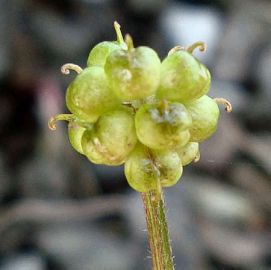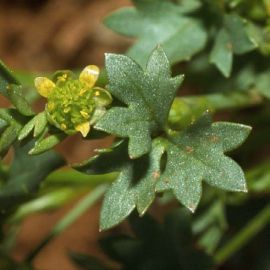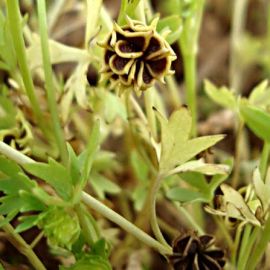H. Eichler, J.A. Jeanes & N.G. Walsh
Herbs, usually terrestrial perennials, some waterplants and some annuals, rarely small shrubs or woody climbers; leaves alternate, in a basal rosette, or rarely opposite or whorled, compound or simple, often palmately lobed or dissected, petioles often with sheathing base, usually without stipules. Inflorescences of solitary flowers or cymose, flowers hypogynous, usually regular, bisexual, nectar-secreting and insect-pollinated, some zygomorphic, rarely wind-pollinated; perianth petaloid or sepaloid, whorled or spirally arranged, undifferentiated or consisting of calyx and corolla, the latter formed usually of petaloid nectaries (sometimes termed ‘honey-leaves’, here treated as petals), rarely of true petals (Adonis), usually 5 or more, rarely reduced to 2, 1 or 0; stamens usually many (rarely 2 or 1), spirally arranged; filaments free, anthers extrorse, opening in longitudinal slits, rarely with connective appendages; carpels many to 1, free and spirally arranged or more or less fused and in 1 whorl; style usually well developed; ovules many to 1, ventral or basal, anatropous; integuments 1 or 2. Fruit of (usually) many (rarely 1) follicles or achenes, or rarely a berry or capsule; seeds usually with a small embryo and oily endosperm; germination usually epigeal.
About 60 genera and c. 2500 species, cosmopolitan, predominantly Northern Hemisphere, many alpine. In Australia 10 genera of which 5 are introduced.
Mostly poisonous to stock and humans (glycosides and alkaloids), some medicinal, several horticultural (e.g. Aconitum, Anemone, Aquilegia, Clematis, Delphinium, Nigella) and sometimes escaping. Previous editions of the Flora listed Batrachium (DC.) Gray as a separate genus, but this is here included in Ranunculus, following Emadzade et al. (2010). Nigella damascena L. (Love-in-a-mist), is a commonly grown ornamental to c. 50 cm high with finely dissected leaves and bracts subtending the attractive white to sky blue or purplish sepals and smaller petals. It sometimes escapes weakly from gardens and has been collected near Crafers and Wirrabara. It does not appear to maintain populations in the wild. Anemone hortensis L. and a species of Aquilegia L. are known from one record each, collected in the Adelaide Hills.
Reference: Tamara (1993), Eichler et al. (2007), Culham (2007), Emadzade et al. (2010).
1. Climbing shrubs; leaves
opposite; stem woody
1: Herbs; leaves basal and/or cauline and alternate; stem herbaceous
2. Flowers
zygomorphic; 1 of the 5
sepals spurred;
fruit a
follicle
2: Flowers regular; fruit a head or spike of many achenes
3. All 5 sepals spurred
4. Small
annual with basal rosette of
linear leaves; flowers very small, solitary on
scapes;
fruit a slender
subulate spike
Aquilegia
4: Larger
perennial with
compound leaves; flowers conspicuous;
fruit a
whorl of several
follicles 3: Sepals without a spur
5. Flowering stem with a whorl of involucral bracts immediately below flower; fruit capsular
Anemone
6. Involucral
bracts 3 (very rarely 2 or 4),
lobed or
entire; tepals white, without nectaries, not clawed;
fruit a cluster of
achenes,
perennialNigella
6: Involuvral
bracts 5, pinnately dissected;
sepals light-blue to white, clawed;
petals with nectaries;
fruit a 5–9 (–12)-celled
capsule of
connate follicles;
annual 5: Flowering stem lacking a whorl of involucral bracts; fruit a head or spike of achenes
7. Petals without nectaries
7: Petals with nectaries at or above the base
H.Eichler (updated by J.A.Jeanes)
(In Greek mythology the name of a beautiful youth, beloved of Persephone and Aphrodite, who was killed by a wild boar and from whose blood grew the flower Adonis.)
Sp. Pl. 1: 547 (1753).
Annual (or perennial) herbs with branching leafy stems; leaves alternate, 2–4-pinnate with narrow-linear segments. Flowers regular, usually solitary, terminal, bisexual, on bractless peduncles; perianth segments not spurred; sepals 5, rarely to 8, appressed or spreading, glabrous or pilose, sometimes petaloid and/or caducous; petals 3–20, intensely coloured, glossy, yellow or red, without claw or nectaries; stamens numerous; carpels numerous; ovules with 2 integuments. Achenes numerous, transversely veined and rugose, glabrous or hairy, at maturity forming an elongated head; fruiting receptacle cylindrically elongated or conical.
About 35 species; native to temperate Eurasia and the Mediterranean area; in Australia, 1 species introduced as a garden ornamental, occasionally escaping and becoming naturalised in all mainland States and also with one record from Flinders Island, Tas.
Some species contain pharmaceutically used glycosides (similar to Digitalis) (Kloot 1976).
Reference: Kloot (1976).
Erect annual herb, 10–50 cm high; stem usually branched, sparsely villous towards base, glabrous above; leaves 2- or 3-pinnate, to 6 cm long, with linear, acute segments, glabrous. Flowers solitary, 15–25 mm diam., on peduncles 1–5 cm long, terminal on stem and branches; sepals appressed to spreading, ovate-oblong, 5–12 mm long, glabrous, dark purplish brown; petals 5–10, suberect, obovate, 7–15 mm long, longer than the sepals, usually yellow, rarely bright-red, with a black basal spot; stamens numerous; anthers dark-purple; carpels 10–50. Achenes 2.5–4 mm long, arranged in a ±cylindrical head 15–25 mm long, each with a short straight green beak, the upper projection on the inner margin close to the beak. Pheasants eye.
S.A.: *FR, *EP, *NL, *MU, *YP, *SL, *SE; *W.A.; *N.T.; *Qld.; *N.S.W; *Vic.; *Tas. Native to southern Europe. In S.A. it occurs as a weed mainly in barley and wheat fields in the NL and northern YP regions. Flowers: Aug.–Dec.
(Proclaimed plant in S.A.)
H.Eichler (updated by J.A.Jeanes)
(Greek name of various climbing plants; Greek klema, a shoot, tendril.)
Sp. Pl. 1: 543 (1753).
Woody climbers (perennial herbs or shrubs); leaves opposite, usually once or twice ternate or 1–4 times pinnate, rarely simple; petioles and petiolules often twining and acting as tendrils. Flowers in dichasial panicles or solitary, regular, bisexual or plants dioecious; perianth segments valvate, rarely imbricate, usually 4 (rarely to 8), petaloid; male flowers with numerous stamens; anthers often with a terminal connective-appendage; sometimes with more or less petaloid staminodes grading into stamens; female flowers with numerous carpels, usually with 1 whorl of staminodes, ovule solitary. Fruit a globular head of 1-seeded achenes, each with a persistent long and often plumose style. Old man’s beard, clematis.
About 300 species; cosmopolitan, especially of temperate regions of the Northern Hemisphere; in Australia 14 endemic species, 2 introduced.
The word ‘flammuliform’ is used in the key and descriptions below to describe the complicated division of leaves of some species where the leaf is cleft into five primary divisions, which are then ternately divided. This leads to a typical condition of 15 leaflets, but by further or incomplete division, there may be as few as 12 or as many as 36 leaflets. The term is derived from Clematis flammula whose leaves demonstrate this type of division.
1. Leaves ternate or imparipinnate, with 5 (–7) or fewer leaflets
2. Plants
deciduous, with
bisexual flowers
2: Plants evergreen,
dioecious
1: Leaves biternate, triternate or flammuliform, with more than 5 leaflets
3. Plants
deciduous, with
bisexual flowers
3: Plants evergreen, dioecious
4. Leaves usually
biternate with up to 9 (–12)
leaflets, sometimes with
leaflets lobed
4: Leaves flammuliform to triternate, with more than 12 leaflets (rarely fewer in some immature leaves)
5. Leaflets usually 12–15 per leaf, broadest below middle; terminal
leaflet 12–45 mm long
5: Leaflets usually 18–36 per leaf, broadest beyond middle; terminal
leaflet 5–15 (–25) mm long
Dioecious strong woody climber to 15 m or more high; leaves ternate; leaflets ovate to deltate, 2.5–9 × 1–5 cm, serrate or sometimes entire, ± acute, usually glabrous. Flowers in numerous axillary panicles, to c. 7 cm in diam.; perianth segments usually 4, caducous, oblong-narrowly ovate, 1.3–3.5 cm long, pubescent below, densely white-tomentose at margin, glabrous above, creamy-white; stamens 4–15 mm long, filaments glabrous; anthers linear-oblong, 1.5–4 mm long, with a subulate appendage 1–3 mm long; staminodes present. Achenes compressed-ovoid 5–7 × 2–3.5 mm, shortly pubescent, rarely glabrous, smooth, brown, margins slightly thickened; style plumose, 2.8–2.8 cm long. Mountain clematis.
S.A.: SE; Qld; N.S.W.; Vic.; Tas. Widespread in eastern Australia mostly in wetter montane forests, but extending to drier open forests. Flowers: Sep.–Jan.
(Vulnerable status in S.A.)
Plate 3F
Photos: 3A, B & C, P.J. Lang; 3D, S.A. Seed Conservation Centre, DEWNR; 3E, D.J. Duval, DEWNR; 3F, B.T. Haywood; 3G, S.A. Seed Conservation Centre, DEWNR.
3E, Clematis aristata, M.J. Thorpe 8, Gower C.P., SE
Dioecious woody climber to 5 m high; leaves flammuliform, usually with 12–15 leaflets; leaflets narrow-ovate to lanceolate, entire or deeply 3-sect, terminal leaflet 12–45 × 1.5–5 (–11) mm, mucronate to emarginate, glabrescent. Flowers in axillary and terminal panicles, to c. 6 cm in diam.; perianth segments usually 4, linear-lanceolate, 2–3 cm long, pubescent below, white-tomentose at margin, glabrous above, pale green to creamy-white; stamens 1.5–5 mm long, filaments glabrous, white; anthers elliptic to ovate, 0.5–1 mm long, without an appendage; staminodes present. Achenes compressed-ovoid 4–5 × c. 2.5 mm, glabrous or with short, sparse hairs, light brown, margins corky; style plumose, 1.5–3.5 cm long.
S.A.: NW, FR, EA, EP, NL, MU, SL, KI, SE; NT; Qld; N.S.W.; Vic.; Tas. Widespread in eastern Australia often in drier inland forests and woodlands, but also in wetter near-coastal forests. Flowers: Jul.–Oct.
Strong deciduous climber with a woody base, 3–5 m high; leaves biternate or flammuliform with 9–15 leaflets, rarely more; leaflets broadly ovate to narrowly oblong, 1.5–4 cm long, entire or sometimes 2- or 3-lobed, acute to obtuse, ± coriaceous, glabrescent. Flowers many in large axillary and terminal panicles, bisexual, to c. 3 cm in diam., fragrant; perianth segments usually 4, oblong, 8–14 mm long, glabrescent below, with narrow, white-tomentose margins, glabrous above, white; stamens 5–10 mm long, filaments glabrous; anthers linear, 3–4 mm long, obtuse, without an appendage; staminodes absent. Achenes strongly compressed, ovoid, 5–6 × 4–5 mm, appressed-pubescent to glabrous, dark brown with paler margins; style plumose, 2–5 mm long.
S.A.: *NL, *MU, *YP, *?SL; *Vic. Eurasia, north Africa. Native of southern Europe, the Mediterranean region and south-western Asia. Grown as an ornamental and questionably naturalised in the S.A. regions listed.
Dioecious woody climber to 5 m high; leaves flammuliform, triternate or incompletely quadriternate, with 18–36 or more leaflets or leaflet-segments; leaflets oblanceolate to obovate, entire or often deeply 3-lobed, often recurved at the margin, terminal leaflet 5–15 (–25) × 1–3 mm, acute to obtuse, mucronate to emarginate, glabrescent. Flowers in axillary and terminal panicles, to c. 4 cm in diam.; perianth segments usually 4, narrow-ovate to oblong, 1.2–2 cm long, short-pubescent below, glabrous above, creamy-white; stamens 2–6 mm long, filaments glabrous, white; anthers broadly elliptic, 0.4–1 mm long, without an appendage; staminodes present. Achenes compressed-ovoid 3.5–5 × 2–3 mm, glabrous, light brown, margins prominent, corky; style plumose, 1.8–3 cm long.
S.A.: FR, EP, YP, KI, SE; Qld; N.S.W.; Vic. Widespread but sporadic in eastern Australia, often in dry open forests and woodlands of rainshadow areas. Flowers: Jul.–Oct.
Dioecious woody climber to 5 m high; leaves mostly biternate with 9 (–12) leaflets; leaflets lanceolate-oblong, oblong or broad-ovate, 8–60 × 3–12 mm, entire or appearing toothed or lobed by incomplete division, usually obtuse, glabrous. Flowers in axillary and terminal panicles, to c. 5 cm in diam.; perianth segments usually 4, linear-lanceolate, 1.3–2.5 cm long, pubescent below, almost glabrous above, creamy-white; stamens 2–5.5 mm long, filaments glabrous, white; anthers ellipsoidal-obloid, 0.4–1 mm long, without an appendage; staminodes present. Achenes compressed-ovoid to compressed broadly ellipsoid, 4–5 × 2–3 mm, glabrous or with short, sparse hairs, light-brown, margins corky; style plumose, 3–5 cm long. Small-leaved clematis, old man’s beard.
S.A.: FR, EP, NL, MU, YP, SL, KI, SE; Qld; N.S.W.; Vic.; Tas. Widespread in eastern Australia in a wide variety of habitats including open forests, heathy woodlands and mallee scrublands. Flowers: Jul.–Oct.
Plate 1C, 1D, 1E, 1F, 1G
Photos: 1A & B, A.C. Robinson; 1C, J. Skinner; 1D, P.J. Lang; 1E, N.R. Neagle, DEWNR; 1F, D.A. Armstrong, DEWNR; 1G, P.J. Ainsley, DEWNR.
1C, Clematis microphylla, female flowers, Belair N.P.
1D, Clematis microphylla, male flowers, Waite Cons. Res., SL
1E, Clematis microphylla, female plant with immature fruit, in sheoak woodland, BS162-1849, SSW of Hardwicke Bay, YP
1F, Clematis microphylla, plant with fluffy mature fruit, Big Heath N.P., SE
1G, Clematis microphylla, mature fruit showing achenes with plumose styles, KI
2.6
*
Clematis vitalba var.
vitalbaStrong deciduous woody climber to 10 m high; leaves imparipinnate with 5, or occasionally 7, leaflets; leaflets ovate, 3–10 cm long, entire, lobed or remotely serrate, acute or acuminate, glabrous or slightly pubescent, more densely so on the veins. Flowers in terminal and axillary panicles, bisexual, c. 2 cm in diam., fragrant; perianth segments oblong, c. 1 cm long, obtuse, with silky hairs above and below, tomentose at the margin, greenish-white; stamens 5–8 mm long, filaments linear, glabrous; anthers oblong, 1–2 mm long, obtuse, without an appendage, staminodes absent. Achenes strongly compressed, ovoid, 3–5 × 1.5–2.5 mm, pubescent, dark brown; style plumose 2–4 cm long. Travellers joy.
S.A.: *EP, *NL, *SL; *Vic.; *Tas. Native of south, west and central Europe. Grown as an ornamental in gardens; escaped and naturalised, e.g. at Crafers. Flowers: Jan., Feb.
The species is an invasive weed in several countries; in New Zealand, it was declared an “unwanted organism”. Populations in S.A. should be monitored for their invasiveness.
Delphinium L. sect. Consolida DC., Syst. Nat. 1: 340, 341 (1817).
H. Eichler (updated by J.A. Jeanes)
(Name of an unknown plant in Roman literature (Apuleius, c. 150 A.D.) from the Latin consolidare, to make firm.)
Nat. Arr. Brit. Pl. 2: 709, 711 (1821).
Annuals with slender taproots; leaves alternate, basal and cauline; lamina palmately lobed or divided. Flowers in racemes or panicles, zygomorphic, bisexual; sepals 5, petaloid, the upper one with a prolonged, conical, basal spur; petals 2, united into a single spurred nectary, its basal spur extending into the sepal spur; stamens numerous, in 5 spirally arranged series, filaments broadening towards base, anthers 2-celled, dehiscing longitudinally; carpel 1; ovules numerous. Fruit a many-seeded follicle.
About 60 species from central Asia to the Mediterranean area; in Australia, one species occasionally escaping cultivation and becoming weakly naturalised.
Consolida has been included by many in Delphinium L. as a section or subgenus.
References: Hilty (2003–2011); Warnock (1997).
Stems to 1 m high, simple or branched, pubescent, becoming glabrous; leaves glabrous or pubescent; basal leaves petiolate, to 10 cm long, with oblong segments; cauline leaves sessile, 1–6 cm long, with linear segments. Inflorescence usually racemose, occasionally paniculate; lower bracts dissected; bracteoles small, remote, usually not reaching base of flower; lower pedicels mostly more than 12 mm long in fruit, but less than twice as long as ripe follicle; sepals 10–14 (–20) mm long, usually deep blue, rarely purple, pink or white, spur 12–20 mm long; petals 3-lobed, with a bifid upper lobe. Follicle 15–25 mm long, c. 5 mm thick, gradually narrowed at apex, becoming erect on ripening, pubescent; seeds black. Eastern larkspur, rocket larkspur.
S.A.: *EP, *SL. Native to the Mediterranean region and widely introduced in Asia and North America; introduced to Australia as an ornamental garden plant occasionally escaping from cultivation in W.A., S.A., N.S.W. and Vic. Flowers: Dec.–Jan.
The name C. ambigua (syn. Delphinium ambiguum L.) has been misapplied widely in modern Australian State floras and check-lists.
H. Eichler (updated by J.A. Jeanes)
(Greek mys, a mouse; oura, a tail; alluding to the long slender fruiting spike.)
Sp. Pl. 1: 284 (1753).
Small, glabrous, tufted, annual herbs; leaves all in a basal rosette, linear-filiform or very narrowly spathulate, somewhat dilated towards the base, entire. Flowers bisexual, actinomorphic, solitary on bractless scapes, terminal; sepals 5, spurred, spurs descending and appressed to stem; petals 5–7 or fewer, sometimes absent, inconspicuous, usually smaller than sepals, filiform-tubular, broadest near the apex; nectary a narrow groove; stamens 5–20. Achenes 20–200 or more, spirally arranged in a slender subulate spike on a greatly elongated fruiting receptacle, each with a stylar beak.
About 15 not well defined species in the temperate regions of both Hemispheres. In Australia only one species recorded; though it has often been reported to be introduced, it may be native and specifically distinct from the European and North American Myosurus minimus L., under which name it has generally been treated.
Plants 3–15 (–20) cm high; leaves narrow-linear, 1–8 (–12) cm × 0.5–1.5 (–2.5) mm, sometimes slightly expanded above, usually withered in fruit. Scapes usually 2–30, 1–3 cm long at anthesis, elongating to c. 10 cm or more in fruit; sepals 1.5–4.5 mm long, yellowish green, caducous; spur 0.5–2 mm long; petals usually 3–5, sometimes absent, 1.5–3.5 mm long, pale yellow, caducous; nectary minute; stamens 5–10. Ripe fruiting spikes cylindric, 0.5–5 cm long, 1.5–2.5 mm thick, gradually narrowed to the apex; achenes typically 100–300 per spike, reddish brown, dorsally diamond-shaped to trullate, about 1–1.5 times as long as broad, 1–1.5 mm long, including the appressed, ascending, 0.2–0.6 mm long beak. Mousetail.
S.A.: NW, LE, GT, FR, EA, EP, YP, MU; W.A.; N.T.; Qld; N.S.W.; Vic.; Tas. Widespread, mostly in moist places near inland watercourses. Flowers: Jul.–Nov.
The European and North American M. minimus differs in the shape of the back of the achenes which is elliptic or oblanceolate to oblong and twice or more as long as broad.
N.G. Walsh
(Diminutive of Latin rana, a frog; name of a plant in the writings of Pliny.)
Sp. Pl. 1: 548 (1753).
Annual or perennial herbs, sometimes aquatics; stems erect, creeping or stoloniferous; leaves spirally arranged, often with a basal rosette, lacking true stipules; blades often palmately lobed or divided, ternate or pinnately dissected or finely divided into capillary segments, sometimes simple and entire. Inflorescence of solitary flowers, sometimes in cymose panicles, bisexual, actinomorphic, all parts arranged spirally; sepals (3–) 5; petals 5–15, rarely fewer, yellow or white, often glossy, each with a nectar-secreting pit on the upper surface usually in the lower half, often near the base, often covered by a lobe which may be adnate at its lateral margins forming a pocket; stamens usually numerous, rarely only 5 or fewer; carpels free, usually numerous, with 1 basal ovule. Fruit a globular or elongated head of smooth to rugose or tuberculate achenes; style usually persistent and forming a glabrous beak. Buttercups, ranunculus.
53 species (11 introduced) in Australia, more than 500 species worldwide, mostly in temperate parts of the Northern Hemisphere. Many species are poisonous to cattle when fresh. Hybrids between species of montane to alpine areas of the eastern states of Australia are common, but hybrids between S.A. species are relatively rare.
1. Petals white with a yellow
claw; aquatic plants; leaves divided into
capillary segments; ripe
achenes transversely
rugose; leaf-sheath stipuloid
1: Petals yellow; usually terrestrial or swamp plants; leaves usually lobed or compound, rarely divided into linear segments; ripe achenes smooth, irregularly rugose or tuberculate, but not distinctly transversely rugose; leaf-sheath gradually tapering into the petiole
2. Leaves simple, narrowly elliptic to lanceolate, the lowermost sometimes nearly orbicular
3. Achenes
granular to
tuberculate;
petals 2.5–4.5 mm long;
annual
3: Achenes smooth (minutely
reticulate under magnification);
petals 4–8 mm long;
perennial
2: Leaves compound, or if simple then palmately or ternately lobed or dissected
4. Achenes less than 1 mm long, very numerous, in elongated
heads;
beak minute; plants
annual (rarely
biennial), rather thick-stemmed, in wet areas
4: Achenes longer than 1 mm long; fruiting heads not elongating; beak usually prominent
5. Plants perennial; roots often fleshy, sometimes tuberous, and/or plants stoloniferous
6. Plants with stolons; basal leaves ternate or palmately lobed or dissected
7. Stolons robust, mostly above ground;
petals 5–10 mm wide; leaves usually
trifoliolate with petiolulate terminal
leaflet
7: Stolons slender, below ground (except sometimes if plants aquatic); petals mostly < 5 mm wide; terminal leaflet (if apparent) not or rarely petiolulate
8. Leaves palmatisect, i.e. the incision of the lateral segments almost to the base and almost as deep as that between the lateral and terminal segments
9. Nectary a swollen crescentic bracket without a
petaloid lobe; leaf
segments ±
linear in submerged leaves, often
cuneate or
obovate-
cuneate in aerial leaves
9: Nectary with a distinct petaloid lobe, often ± attached at the lateral margins and forming a pocket
10. Ultimate
segments of leaves wider than 2 mm;
sepals usually hairy below; margin of
achenes conspicuously thickened
10: Ultimate segments of leaves narrowly linear, c. 1 (–2) mm wide; sepals glabrous; margin of achenes not conspicuously thickened
11. Leaves 1–5 cm diam.;
petioles to 15 cm long;
achenes 1.5–1.8 mm long
11: Leaves 5.5–13 cm diam.;
petioles to 45 cm long;
achenes 2–4 mm long
8: Leaves trifoliolate or ternately divided, the incision of the lateral segments less deep than that between the terminal and lateral segments
12. Nectary lacking a
petaloid lobe; plants mostly aquatic or semi-aquatic, less often exposed on permanently wet soils
12: Nectary with a petaloid lobe c. 0.5 mm long or more; plants mostly terrestrial in seasonally wet sites
13. Achenes with 2–5 prominent, broad,
oblique or nearly longitudinal ridges, or sometimes boldly
reticulate on lateral faces
13: Achenes irregularly wrinkled, or obscurely ridged, or pitted, or smooth
14. Petals 7–12 mm long;
achenes 1.7–3.6 mm long
14: Petals 3.5–6.5 mm long;
achenes 1–1.8 mm long
6: Plants without stolons; basal leaves 3-lobed, 3-partite to more or less biternately cut or lobed
15. Stem and
petioles with short
appressed hairs throughout; basal leaves few, dissected into narrow almost
linear segments;
roots fleshy, more or less tuberous
15: Stem and petioles with long spreading hairs at least in their lower part; basal leaves several to many, with broad lanceolate to obovate segments
16. Achenes more or less
globular, with very thick
pericarp;
roots fleshy, more or less tuberous; basal leaves usually
simple, 3-
lobed to 3-
partite, broad-
ovate or as wide as long
16: Achenes
lenticular, with thin
pericarp;
roots fibrous (sometimes thick); basal leaves usually
ternate (at least the later ones), to biternately
lobed,
ovate in outline, longer than wide, the central
leaflet distinctly longer stalked than the lateral
leaflets
5: Plants annual; roots fibrous, stolons not produced
17. Achenes smooth and glabrous on lateral faces
18. Achenes more or less
lenticular, thicker in the centre than at the margin, not twisted, 1.5–2 mm long;
sepals 3 or 4; plants hairy
18: Achenes strongly flattened, very thin, papery, with a thickened margin, often somewhat twisted when ripe, 2–4 mm long;
sepals 3–5; plants almost
glabrous
17: Achenes with spines, tubercles and/or hairs on lateral faces
19. Plants slender; flowers inconspicuous, 2–6 mm diam., often sessile or subsessile; receptacle glabrous; sepals usually spreading (reflexed in R. parviflorus); petals usually fewer than 5
20. Plants almost
glabrous;
achenes strongly flattened, very thin, papery, with a thickened margin, often somewhat twisted when ripe, 2–4 mm long, with small conical
tubercles scattered over the central part of the faces, each terminated by a short recurred hair
20: Plants hairy; achenes flattened but neither papery-thin nor twisted; ornamentation of achenes not confined to central parts of faces
21. Achenes 1.3–2 (–2.5) mm long; fruits often almost sessile
22. Basal leaves ternate, with linear to narrow-lanceolate leaflet-segments
23. Achenes more or less
lenticular, their faces covered by hairs which sit on very short
tubercles;
sepals 5
23: Achenes flat, with prominent conical
tubercles scattered over the faces;
sepals 3 or 4
22: Basal leaves palmate to
palmatifid, coarsely
toothed or
lobed
21: Achenes 2.5–5 mm long; fruits mostly pedicellate
24. Achenes on lateral faces with long thin
subulate tubercles (
bristles), each terminated by a short
recurved hair,
stipitate at the base;
sepals 3,
spreading;
petals 1-nerved, nerve sometimes forked towards the apex
24: Achenes on lateral faces with short conical
tubercles, each terminated by a
recurved bristle, not or only shortly
stipitate;
sepals 4 or 5,
reflexed;
petals with 3 principal
nerves, all once or twice forked in the lower half
19: Plants robust, nearly glabrous; flowers conspicuous, 8–15 mm diam.; receptacle hairy; sepals usually reflexed (spreading or appressed to petals in R. arvensis); petals usually 5
25. Achenes 2–3.5 mm long, with short conical tubercles
26. Petals up to 1.5 times as long as
sepals;
achenes with numerous small
tubercles, flat-
ovate-
orbicular;
beak recurved; plants usually subglabrous
26: Petals 2–3 times as long as
sepals;
achenes usually with few small
tubercles mainly towards the margin (rarely faces evenly
tuberculate), flat-
orbicular;
beak upcurved or straight; plants usually distinctly
pilose
25: Achenes 5–8 mm long, with slender almost spiny tubercles
27. Sepals
spreading;
tubercles of
achenes c. 3 mm long; leaves mostly deeply
lobed or
trifoliolate
27: Sepals
reflexed;
tubercles of
achenes c. 1 mm long; leaves
entire or shallowly 3-
lobed
Stoloniferous perennial, usually partially or entirely submerged; leaves with lamina trifoliolate to palmatisect, 1–5 (–7) cm diam., ± circular in outline, glabrous; segments linear-oblong when deeply submerged, cuneate to obovate when aerial, 3-toothed or 3–many-lobed; petioles 1–15 cm long. Flowering stems 1–10 cm long, erect to spreading, 1–4-flowered; sepals 4 or 5, spreading (sometimes ± reflexed), broadly ovate, 2–3 mm long, glabrous; petals 4–9, oblong to narrowly obovate, 2–4 mm long; nectary a swollen crescentic pocket or bracket at about one-third petal length from base; stamens c. 10–18; pistils c. 6–15; receptacle hispid in stamen-zone, glabrous or with few hairs in achene-zone. Achenes sublenticular, 1.5–2 mm long, somewhat swollen, smooth or slightly wrinkled or warted; beak slender, straight or slightly curved, almost as long as achene-body. River buttercup, small river buttercup.
S.A.: FR, NL, MU, SL, KI, SE; W.A.; Vic.; N.S.W.; Tas. N.Z. Moderately common in swamps, pools and slow-flowing streams, of the south-east; recorded at 8 m depth near the Vic. border. Flowers: all months, mostly Oct.–Mar.
Plate 2E
Photos: 2A, D.J. Duval, DEWNR; 2B, R.J. Bates; 2C & D, A.C. Robinson, DEWNR; 2E, A.C. Robinson; 2F, D.J. Duval, DEWNR.
2E, Ranunculus amphitrichus, habit of non-submerged plant showing stolons, flowers and fruit, North-West River, KI
Stoloniferous perennial; basal leaves with lamina palmatisect, 5–13 cm diam., glabrous; ultimate segments 0.5–2 mm wide; petioles 5–45 cm long, glabrous. Flowering stems 10–30 cm high, 1–3-flowered, glabrous or pilose just below flowers; sepals 5, spreading, 3–6.5 mm long, glabrous or shortly ciliate near basal margin; petals 8–16, narrowly obovate to obovate, 5–13 mm long, yellow, obtuse or emarginate; nectary near petal base, c. 1 mm long, lobe rounded to truncate, free for up to 1/4 its length; stamens 20–45; pistils 25–45; receptacle shortly hirsute in stamen-zone, hairs scattered between achenes. Achenes ± lenticular, 2–4 mm long, lateral faces smooth or somewhat warty, sometimes indistinctly rippled; beak reflexed, c. 1/4–1/3 as long as achene-body.
S.A.: SE; Vic. A species of seasonal swamps and lake margins. Largely confined to south-western Victoria, from the southern Grampians to near Portland, with outliers c. 40 km north-east of Melbourne and near Glencoe in south-eastern S.A. Flowers: Oct.–Nov.
Plants may be partially submerged, but leaves and flowering stems usually emergent.
Plate 2B
Photos: 2A, D.J. Duval, DEWNR; 2B, R.J. Bates; 2C & D, A.C. Robinson, DEWNR; 2E, A.C. Robinson; 2F, D.J. Duval, DEWNR.
2B, Ranunculus amplus, flowers and leaves held in front of swamp habitat, Hackett Hill, SE
Erect, sparsely pilose annual; lower leaves with lamina obovate or broadly spathulate, 2–4 cm long; petioles 1.5–7 cm long; stem-leaves trifoliolate with obovate or linear-elliptical segments, these sometimes further 3-toothed or shallowly lobed. Flowering stems 15–60 cm high, 3–7 (–15)-flowered, pedicels with sparse, recurved hairs; sepals 5, spreading, ovate, 5–7 mm long, pale yellowish green, pilose beneath; petals 5, obovate, 7–10 mm long, bright lemon-yellow, margins minutely ciliate; nectary near petal-base, lobe cuneate or obovate, wider than petal just above its attachment, 1–2 mm long, free for up to half this length; stamens 10–12; pistils 6–12; receptacle hirsute. Achenes broadly obovate, 6–8 mm long, strongly flattened, lateral faces with prominent, almost spiny tubercles to 3 mm long, longer near margins; beak 2–3 mm long, erect, straight to falcate. Corn buttercup.
S.A.: *SE; *N.S.W.; *Tas. Native to north Africa, southern Europe and south-west Asia. Known in S.A. from a single record (1883) and probably not persisting. Flowers: Sep.–Oct. in other states.
Stoloniferous perennial; leaves with lamina trifoliolate, 0.5–2 cm long and wide, the 3 segments oblong to narrowly elliptic, entire or with 2 or 3 lobes or teeth; petioles 2–10 (–12) cm long. Flowering stems 1–10 cm long, 1 (–3)-flowered; sepals 5–8, spreading, ovate to broadly elliptic, 3–5 mm long, glabrous or sparsely pilose; petals oblong to obovate, 3–6.5 mm long, bright yellow; nectary near petal base, pocket-like, lobe c. 0.5 mm long, apex shallowly emarginate, truncate, or shortly rounded; stamens 15–30; pistils 6–30; receptacle sparsely hispid. Achenes flattened-obovoid, 1–1.8 mm long, the lateral faces smooth or finely wrinkled or obscurely ridged; beak slender, erect, c. 1 mm long.
S.A.: SE; N.S.W.; Vic.; Tas. A species of seasonal swamps and lake margins. Known in S.A. only from the Penola region (1977). Flowers: Sep.–Feb.
5.5
*
Ranunculus flammula subsp.
flammulaErect or ascending perennial, to c. 80 cm high, glabrous or with scattered appressed hairs; mostly rooting at lower nodes; leaves mostly cauline, the lower with lamina narrow-elliptic to lanceolate, 1–6 (–12) cm × 2–15 (–30) mm, acute, entire or with a few small teeth; petioles to c. 10 cm long; upper leaves usually smaller, relatively narrower and (sub-) sessile. Inflorescence cymose, few–many-flowered; sepals 5, rarely 4, spreading, ovate to obovate, 2–4 mm long, appressed-hairy beneath; petals 5, obovate-cuneate, 4–8 mm long, pale yellow; nectary near petal base, lobe cuneate, truncate, c. 0.2 mm long, fused for entire length; stamens 25–40; pistils c. 10–50; receptacle glabrous. Achenes obovate, 1–2 mm long, smooth, minutely reticulate (under magnification), obscurely bordered, glabrous; beak minute, blunt. Lesser spearwort.
S.A.: *SL; *N.S.W.; *Vic.; *Tas. Native to NW Africa, Europe, Asia. A weed of swamps and creeklines. Recorded from few sites near Mt Lofty and the Fleurieu Peninsula. Flowers: Nov.–Mar.
Stoloniferous perennial; leaves with lamina trifoliolate or deeply palmatisect, ± orbicular in outline, 1–7 cm diam.; leaflets narrowly elliptic (rarely linear) to obovate-cuneate, usually deeply lobed, ultimate segments mostly 1–3 mm wide, glabrous or with few scattered hairs; petioles 1.5–16 cm long. Flowering stems erect, to c. 30 cm long, 1–3-flowered, usually appressed-hirsute; sepals 5, spreading, ovate, 4–8 mm long, appressed-hairy below; petals 5–15, oblanceolate to obovate, 5–11 mm long, golden-yellow; nectary near petal-base, pocket like, ± 0.5–1 mm long, apex of lobe shallowly emarginate or sinuate, often asymmetric, margins excurrent; stamens 12–50; pistils 9–15; receptacle glabrous. Achenes inflated, subglobular or broadly obovate, 2.7–4 mm long, the lateral faces with 3–4 broad, oblique ridges; beak erect or reflexed, c. 1.5 mm long. Shining buttercup.
S.A.: SE; Vic.; Tas. N.Z. A species of seasonally damp or inundated areas. Uncommon, known from a few sites in the far SE, and a 1907 record from Bridgewater. Flowers: Sep.–Jan.
(Vulnerable in S.A.)
Plate 2F
Photos: 2A, D.J. Duval, DEWNR; 2B, R.J. Bates; 2C & D, A.C. Robinson, DEWNR; 2E, A.C. Robinson; 2F, D.J. Duval, DEWNR.
2F, Ranunculus glabrifolius, DJD1759, Honan Scrub N.F., SE
Slender annual, 3–25 cm high; stems simple or branching from base; ± densely pilose at least near base: adult leaves with lamina reniform to ± semiorbicular in outline, 5–25 mm long, deeply trifid, median segment entire or coarsely 3-dentate, lateral segments 2-lobed, each up to 3-toothed; petioles 1–6 cm long; lower pedicels (when fruiting) 7–30 mm. Flowers, at least the upper ones, subsessile; pedicels (in fruit) to 30 mm; sepals 3, spreading 2–2.5 mm long, pilose below; petals 0–2, oblong, c. 2–2.25 mm long, 1-nerved, but this usually forked toward apex; nectary-scale above middle of petal, minute, semielliptic to semiorbicular; stamens 4 or 5; pistils 10–17; receptacle glabrous. Achenes obliquely ovate, 3–5 mm long, virtually flat, ± stipitate, margin thickened, smooth, lateral faces with 15–20 long bristles each terminated by a short curved hair; beak triangular, slightly curved, up to half total achene length, terminating in a short hook.
S.A.: LE, FR, EA, EP, NL, MU, SL. Occurs in shady humid places, often between rocks. Flowers: Jul.–Sep.
Endemic to S.A.
Stoloniferous perennial; basal leaves with lamina palmatisect, 1–5 cm diam., glabrous or with few hairs beneath; ultimate segments 0.5–2 mm wide; petioles 1–15 cm long, ± glabrous. Flowering stems 5–30 cm high, 1–3-flowered, glabrous, ± pilose at base; sepals 5, spreading to reflexed, 2–3.5 mm long, glabrous; petals 5–12, narrowly obovate to oblanceolate, 4–10 mm long, yellow, obtuse; nectary near petal base, c. 1 mm long, lobe obtuse, often oblique, free for half to two-thirds of its length; stamens 20–30; pistils 20–45; receptacle shortly hirsute in stamen-zone, subglabrous between achenes. Achenes ± lenticular, 1.5–1.8 mm long, lateral faces almost smooth or irregularly warty; beak reflexed, about half to two-thirds as long as achene-body. River buttercup.
S.A.: MU, SL, KI, SE; Qld; N.S.W.; Vic. Usually in shallow water and with leaves either floating or submerged, rarely on wet ground. Flowers: Sep.–Jan.
Rare in S.A. known from a few sites on the Fleurieu Peninsula, Kangaroo Island and near the Victorian border.
Tufted perennial; roots fibrous to, rarely, fleshy-subtuberous; leaves mostly basal, lamina ovate to deltoid in outline, 1.5–8 (–11) cm long and wide, ternate (at least the later ones), to biternately lobed, leaflets usually deeply dissected or lobed, longer than wide, the central leaflet distinctly longer stalked than the lateral leaflets, appressed-hirsute, sometimes with well developed petiolules; petioles 2–30 cm long with spreading and/or appressed hairs. Flowering stems 4–70 (–170) cm high, (1–) 2–10-flowered, with spreading and/or appressed hairs; sepals 5, spreading, elliptic, 4–7 (–10) mm long, hairy below; petals 5, obovate-cuneate, 7–17 (–22) mm long, obtuse, bright yellow; nectary near petal base, lobe cuneate, c. 1–2.8 mm long, free for most its length; stamens 40–110; pistils 20–50; receptacle glabrous in stamen-zone, hirsute above. Achenes lenticular, obovate-cuneate, 1.7–3.5 mm long, margin narrowly ridged, lateral faces smooth or dimpled; beak slender, 0.8–1.8 mm long, arched, tip recoiled. Common buttercup, Australian buttercup.
S.A.: LE, FR, EP, NL, MU, SL, SE; Qld; N.S.W.; Vic.; Tas. Occurs in southern Eyre Peninsula, southern Flinders Ranges, Fleurieu Peninsula and the far south-east, mainly in moist sites, e.g. swamp margins, shaded forest and woodlands. Flowers: Jul.–Dec.
Plate 3A, 3B, 3C
Photos: 3A, B & C, P.J. Lang; 3D, S.A. Seed Conservation Centre, DEWNR; 3E, D.J. Duval, DEWNR; 3F, B.T. Haywood; 3G, S.A. Seed Conservation Centre, DEWNR.
3A, Ranunculus lappaceus, PJL 2767, Waite Cons. Res., SL
3B, Ranunculus lappaceus, PJL 2767, Waite Cons. Res., SL
3C, Ranunculus lappaceus, PJL 2767, Waite Cons. Res., SL
Suberect or spreading annual, glabrous to pilose; basal leaves with lamina ± orbicular, ± cordate, 1.5–5 cm long, with 3–5 shallow rounded coarsely crenate-dentate lobes; petioles 5–15 cm long; upper cauline leaves ± cuneate, with 3 narrow, entire or toothed segments. Flowering stems 10–50 cm high, 1–10-flowered; sepals 5, strongly reflexed, ovate, c. 5 mm long, sparsely pilose below; petals 5, obovate, 7–9 mm long, slightly longer than sepals, yellow; nectary near petal base, lobe obovate to cuneate, 1–2 mm long, free for up to half this length; stamens 15–20; pistils 8–20; receptacle pubescent. Achenes broadly obovate, 5–8 mm long, flattened, brown with a green, strongly keeled and grooved, smooth margin, faces with numerous, acute tubercles c. 1 mm long (rarely the faces almost smooth); beak stout, 2–3 mm long, nearly straight. Sharp buttercup, burr (or prickle-fruit) buttercup.
S.A.: *FR, *EP, *NL, *MU, *SL, *SE; *W.A.; *Qld; *N.S.W.; *Vic.; *Tas. Native to northern Africa, Europe and west Asia, widely naturalized. A weed of damp sites, e.g. agricultural areas, ditches, parks and lawns. Fairly common in Adelaide area, otherwise scattered from southern Flinders Range south-east to the Victorian border. Flowers: Aug.–Dec.
5.11
*
Ranunculus ophioglossifoliusErect or ascending annual to c. 50 cm high, often rooting from lower nodes, glabrous or with few appressed hairs; leaves mostly cauline, the lower ones with lamina ovate or suborbicular, to c. 40 × 20 mm, sometimes cordate at base; petioles to c. 12 cm long; upper leaves narrow-elliptic, to 65× 10 mm, shortly petiolate, becoming smaller and ± sessile above; all entire or obscurely callous-toothed. Inflorescence cymose, of few to many flowers; sepals 4 or 5, spreading or slightly recurved, ovate to obovate, 2–4 mm long, with appressed hairs beneath; petals obovate-cuneate, 2.5–4.5 mm long, pale yellow; nectary near petal-base, lobe broad, triangular or retuse, c. 0.2 mm long, free; stamens c. 6–10; pistils 20–50; receptacle glabrous. Achenes flattened-ovoid, 1.5–2 mm long, obscurely bordered, faces granular to tuberculate; beak ± triangular, 0.5–1 mm long. Snake-tongue buttercup.
S.A.: *SE; *Vic. Native to north Africa, Europe and western Asia. Currently known only from the Penola-Millicent area. Aquatic or semi-aquatic weed of swamps, lagoons etc.
Tufted perennial; roots often subtuberous, tapering distally; leaves mostly basal, lamina ovate to elliptic in outline, 0.8–4.5 cm long and wide, 3-lobed to deeply ternately dissected, the segments acutely toothed or further lobed, with soft subappressed hairs; petioles 1–12 cm long, with spreading or subappressed hairs. Flowering stems 5–20 (–40) cm high, 1–5-flowered, hairs spreading near base, usually appressed above; sepals 5, spreading, ovate to obovate, 3–7 mm long, with spreading hairs below; petals 5, obovate-cuneate, 6–15 mm long, golden-yellow; nectary near petal-base, lobe oblong to cuneate, 1–2 mm long, free for c. half its length; stamens 25–45; pistils 15–30; receptacle glabrous in stamen-zone, pubescent above. Achenes globular or plumply obovoid-cuneate, 2.5–5 mm long, lateral faces smooth, often with shallow dorsal groove; beak 1.5–2 mm long, recurved or straight with recurved tip. Thick-fruited buttercup.
S.A.: FR, NL, MU, YP, SL, KI, SE; N.S.W.; Vic. Locally common in woodlands of rocky sites in river valleys and in seasonally wet sites on sandy or clay substrates. Flowers: Jul.–Nov.
Sometimes growing with the similar R. robertsonii and plants of apparently hybrid origin may occur in these areas.
Plate 3D
Photos: 3A, B & C, P.J. Lang; 3D, S.A. Seed Conservation Centre, DEWNR; 3E, D.J. Duval, DEWNR; 3F, B.T. Haywood; 3G, S.A. Seed Conservation Centre, DEWNR.
3D, Ranunculus pachycarpus
Stoloniferous perennial; leaves with lamina trifoliolate, sometimes appearing digitate due to deep division of lateral segments, 1.5–5 cm long and wide; segments cuneate to narrow elliptic, 2–6 (–12) mm wide, each with 3–5 lobes or teeth, rarely entire, glabrous or with a few scattered hairs above, sparingly pilose below; petioles 4–25 cm long. Flowering stems 10–30 cm long, erect, 2–4-flowered, ± pilose under the flowers and glabrescent below; sepals 5 (6), spreading, ovate to oblong, ± 5 mm long, ± shortly hispid below, rarely glabrous; petals 5–15, elliptic to oblanceolate, 7–12 mm long, yellow; nectary near petal-base, ± 0.5 mm long, pocket-like, apex emarginate or truncate, or a short rounded lobe developed; stamens 15–40; pistils 20–50; receptacle sparsely hispid in achene zone. Achenes obliquely obovoid to broadly cuneoid, 1.7–3.6 mm long, lateral faces smooth, irregularly warty or undulate; beak slender, erect to reflexed, 0.8–2.4 mm long. Large river-buttercup.
S.A.: MU, SL, SE; N.S.W.; Vic. At swamp and river margins, scattered from the southern Fleurieu Peninsula to the Vic. border near Penola. Flowers: Dec.-Jan.
(Vulnerable in S.A.)
Decumbent to ascending annual, sparsely to densely pilose; basal leaves with lamina orbicular-reniform, 1.5–4 cm diam., palmately 3–5-lobed, lobes coarsely toothed, hairy on both surfaces; petioles 3–10 cm long; cauline leaves similar, but lobes often narrower; uppermost leaves often entire, ± sessile. Flowering stems 10–40 cm high, 2–10-flowered; sepals 4 or 5, reflexed, ovate, c. 2 mm long, densely pilose below; petals 2–5, obovate, 2–3 mm long, pale yellow; nectary near petal-base, lobe ± ovate, c. 0.4 mm long, free above midway; stamens 5–8; pistils 6–24; receptacle glabrous. Achenes orbicular-ovate, 2.5–3 mm long, brown with paler, keeled narrow margin, faces ± evenly covered with short tubercles, each terminated by a short hooked bristle; beak triangular or hooked at apex, c. 0.5 mmm long. Small-flowered buttercup.
S.A.: *NL, *SL, *SE; *N.S.W. (also Lord Howe Is., Norfolk Is); *Vic; *Tas. N.Z. Native to north Africa, southern Europe and western Asia. Typically a weed of ditches, depressions, wet pasture, etc., but in S.A. currently known only from Mt Lofty Ranges and the far south-east near Mt Gambier. Flowers: Nov. (1 record).
5.15
Ranunculus pentandrus
Slender ± erect annual, 2–40 cm high, glabrous or sparingly pilose; stems usually branched from base; adult lower leaves with lamina trifoliolate, 0.7–2.5 cm long, leaflets ternately dissected into narrow-lanceolate to nearly linear lobes; petioles 1.5–5 cm long. Lower flowers usually pedicellate with fruiting pedicels to 3 cm long, upper flowers subsessile; sepals 3–5, elliptic to obovate-oblong, 1.7–2 mm long; petals 1 or 2, elliptic to obovate-spathulate, 1.5–2 mm long, whitish; nectary near middle of petal, lobe ± semicircular, c. 0.2 mm long; stamens 3–5; pistils 6–20; receptacle glabrous. Achenes suborbicular to broadly ovate, 2–4 mm long, strongly flattened, often twisted, margins smooth, slightly thickened, pale reddish brown; beak triangular, 0.3–1 mm long. Smooth buttercup.
1. Lateral faces of
achenes smooth,
glabrous, without or with very few
tubercles
1: Centre part of lateral faces of
achenes with
scattered short conical
tubercles, each terminated by a short,
recurved bristle or hair
5.15a
Ranunculus pentandrus var.
pentandrus Achenes with lateral faces mostly smooth and glabrous, rarely with up to 10 small tubercles and these with or without a microscopic hooked bristle.
S.A.: LE; Qld; N.S.W. Confined to north-western S.A. and rather rare (Pandie Pandie area). Generally a species of floodplains or watercourses and their immediate environs. Flowers: Aug.
5.15b
Ranunculus pentandrus var.
platycarpus Achenes with c. 20 or more short conical tubercles over the central part of each face, each tubercle terminated by a recurved hair or bristle.
S.A.: NW, LE, GT, FR, EA, EP, MU, SL; Qld; N.S.W.; Vic. Mainly in the vicinity of inland watercourses and other areas prone to inundation. Flowers: June–Sep.
Plate 2C, 2D, 3E
Photos: 2A, D.J. Duval, DEWNR; 2B, R.J. Bates; 2C & D, A.C. Robinson, DEWNR; 2E, A.C. Robinson; 2F, D.J. Duval, DEWNR.
Photos: 3A, B & C, P.J. Lang; 3D, S.A. Seed Conservation Centre, DEWNR; 3E, D.J. Duval, DEWNR; 3F, B.T. Haywood; 3G, S.A. Seed Conservation Centre, DEWNR.
2C, Ranunculus pentandrus var. platycarpus, BS164-19, Mt Willoughby Station, LE
2D, Ranunculus pentandrus var. platycarpus, BS164-19, Mt Willoughby Station, LE
Ranunculus pentandrus var. platycarpus, DJD1950, Copper Hills, LE
Slender annual, 1–40 cm high, ± densely pilose, at least in lower part; stems branched from base; adult leaves with lamina trifoliolate or palmatisect, 0.5–2.5 cm long, the ultimate lobes lanceolate to linear acute, mostly 0.5–1.5 mm wide; petioles 1–7.5 cm long. Flowers generally pedicellate (upper flowers sometimes sessile); pedicels 3–15 mm long (to 5 cm in fruit); sepals 3–5, elliptic to obovate, c. 2 mm long; petals 2–4, ovate-spathulate, 1.5–2 mm long, yellow; nectary lobe above middle, minute, semi elliptic or triangular; stamens 4–6; pistils 10–25; receptacle glabrous. Achenes suborbicular, biconvex, 1.5–2 mm long; beak ± triangular, obtuse or minutely hooked, c. 0.2 mm long. Smallflower buttercup, ferny buttercup.
1. Achenes ± densely covered with c. 50 minute
tubercles each bearing a short stiff curved or
appressed hair;
sepals 5
1: Achenes smooth,
glabrous;
sepals 3 (rarely 4)
5.16a
Ranunculus pumilio var.
politus Sepals 3, or very rarely, 4. Achenes with lateral faces smooth and glabrous.
S.A.: FR, EA, MU, SE; N.S.W.; Vic. Scattered from the northern Flinders Range to the Vic. border near Bordertown. Flowers: Jul.–Oct.
Largely co-extensive with var. pumilio but much rarer. Although vegetatively indistinguishable from var. pumilio, the consistent differences in fruit and sepal number suggest it could warrant recognition as a distinct species.
(Vulnerable in S.A., presumed extinct in MU.)
5.16b
Ranunculus pumilio var.
pumilio Sepals 5. Achenes with lateral faces ± densely covered with 20 or more (usually c. 50) minute tubercles, each terminated by a short, stiff, curved or appressed hair; hairs distinctly longer than subtending tubercles.
S.A.: NW, LE, GT, EA, EP, MU, YP, SL, KI, SE; W.A.; Qld; N.S.W.; Vic. Reasonably common on fringes of swamps, lakes, watercourses and areas prone to inundation. Flowers: Aug.–Nov.
Stoloniferous perennial; stolons rooting at nodes; basal leaves very variable, lamina triangular-ovate, 2–15 cm long, trifoliolate, sometimes ± variegated; leaflets petiolulate, broadly ovate, entire and irregularly toothed, or further ± ternately (sometimes ± biternately) dissected, subsericeous (rarely), pilose or ± glabrous; petioles 2–35 cm long; uppermost stem-leaves sessile, linear-lanceolate, entire. Flowering stems 15–75 cm high, 1–3 (–5)-flowered, pilose to subsericeous; sepals 5, appressed or spreading, ovate to broad-elliptic, 5–8 mm long, pubescent below; petals usually 5, broadly obovate, 6–15 mm long, yellow, glossy; nectary near petal-base, lobe obovate to cuneate, 1–2 mm long, free for most of this length; stamens 35–75; pistils c. 20–50; receptacle hispid. Achenes ± orbicular, 2.5–3.5 mm long, strongly laterally compressed, glabrous, finely punctulate, distinctly margined; beak c. 1 mm long, straight or curved. Creeping buttercup.
S.A.: *NL, *SL, *SE; *Qld; *N.S.W.; *Vic.; *Tas. Native to north Africa, Europe and Asia. Localised, but locally well established (Pt Pirie, Adelaide and Millicent areas), mostly damp roadsides, paddocks, margins of ponds, etc. Flowers: Oct.–Dec.
Tufted perennial; roots tuberous, abruptly tapered; leaves mostly basal, lamina ovate to deltoid in outline, 12–25 mm long, deeply trifid to ternately or biternately dissected, or commonly trifoliolate with narrowly trifid or further divided leaflets, ultimate lobes lanceolate to narrowly linear, acute; petioles 1–9 cm long with short appressed hairs. Flowering stem 5–25 cm high, 1–3-flowered, hairs appressed; sepals 5, spreading, ± ovate, 3–5.5 mm long, hirsute below, rarely glabrous; petals 5, obovate-cuneate, 8–14 mm long, bright yellow; nectary near petal-base, lobe cuneate, 1.5–2 mm long, truncate or emarginate, free for c. half its length; stamens 30–35; pistils 15–35; receptacle glabrous in stamen-zone, hirsute above. Achenes lenticular to obcuneate, 1.1–1.5 mm long, margins usually thickened, often with short irregular intersecting ribs; lateral faces irregularly dimpled, beak slender, 0.9–1.2 mm long, straight, tip recurved. Slender buttercup.
S.A.: SE; Vic. Mostly in low-lying sites, sometimes slightly saline, on sandy soils. Flowers: Aug.–Oct.
See note under R. pachycarpus.
(Rare in S.A., between c. Padthaway, Mt Gambier and the Vic. border.)
Erect, pilose to subglabrous annual, tufted or rarely developing short stolons in very wet sites; basal leaves with lamina triangular-ovate in outline, 2–8 cm long, deeply 3-lobed or trifoliolate, sometimes distinctly petiolulate; leaflets irregularly cut or toothed or crenate; petioles 6–32 cm long; cauline leaves shortly stalked or sessile and less divided. Flowering stem 5–18-flowered, hollow, 10–50 cm high; sepals 5, reflexed, ovate, 4–7 mm long; petals 5, obovate, 8–14 mm long, pale yellow; nectary near petal-base, lobe obovate to cuneate, c. 1 mm long, attached only at base; stamens c. 40–60; pistils 30–40; receptacle hairy. Achenes in slightly elongated head, flattened, suborbicular, 2–2.5 mm long, greenish brown, faces with small obtuse tubercles near green margin, rarely smooth or evenly tuberculate; beak c. 0.5 mm long, curved upwards.
S.A.: *SL; *N.S.W.; *Vic.; *Tas. Native to north Africa, Europe and western Asia. Collected from wet pasture and swamps near Adelaide (1968), Mt Compass (1986) and Nangkita (1991), and locally abundant in suitable seasons. Flowers: Oct.–Dec. (3 records).
5.20
*
Ranunculus sceleratus subsp.
sceleratusErect semi-aquatic annual 20–80 cm high, glabrous or with scattered soft hairs; stem stout, hollow, ridged, branched above; lower leaves with lamina broadly ovate to reniform, cordate, 2–8 cm long, palmately 3–5-lobed, lobes obovate-cuneate, shallowly 3-lobed and crenate; petioles 2–30 cm long; upper leaves sessile, deeply trifid with ± oblong segments, or simple. Inflorescence cymose, usually many-flowered; sepals 5, reflexed, obovate, 2–4 mm long, pilose beneath; petals 5, narrowly ovate to broadly obovate, 3–4 mm long, pale yellow; nectary near petal-base, a ± circular pit c. 0.5 mm diam., lacking a covering lobe or flap; stamens usually c. 20; pistils very numerous (up to c. 700); receptacle hairy. Achenes in an elongated head, glabrous, flattened-obovoid, c. 1 mm long; beak minute. Celery buttercup.
S.A.: *MU, *SE; *W.A.; *Qld; *N.S.W.; *Vic.; *Tas. Native to north Africa, Europe and western to central Asia. Locally common in wetlands associated with the Murray River (Chowilla, Murray Bridge areas), with an isolated record from Comaum Forest against the Vic. border in the south-east. Flowers: Nov.–Apr.
Poisonous to stock. The elongated fruiting head and abundant small achenes are distinctive. The common name reflects its superficial vegetative appearance to Celery.
(Proclaimed weed in S.A.)
5.21
Ranunculus sessiliflorus
Slender annual, 2–35 cm high, sparingly to ± densely pilose on lower part; stems usually branched near base; adult leaves with lamina palmatisect or trifoliolate, 4–15 mm long, the median segment 3-dentate, the lateral ± 2-fid with 3 or 4 teeth to each lobe; petioles 2–5 cm long. Flowers leaf-opposed, sessile or nearly so, the lower ones occasionally shortly pedicellate with fruiting pedicels to 1.5 cm long; sepals 3 or 4, oblong to elliptic, c. 2 mm long, pilose below; petals 0–2, elliptic- to linear-spathulate, 1–2 mm long; nectary lobe above the middle, minute, ± triangular, obtuse; stamens 3–6; pistils 6–20; receptacle glabrous. Achenes suborbicular to obovate, 1.3–2.5 mm long, virtually flat, the lateral faces each bearing 7–25 conical tubercles terminated by a recurved bristle; beak short-triangular, 0.3–0.5 (–1) mm long, ± acute. (Australian) smallflower buttercup.
1. Leaves palmatilobed or
palmatisect or 3- or 5
-fid, but not distinctly
compound;
segments cuneate to flabelliform
1: Leaves
trifoliolate; each
leaflet further divided into
linear to narrowly
lanceolate segments
5.21a
Ranunculus sessiliflorus var.
pilulifer Leaves deeply ternately, biternately or triternately divided with ultimate segments linear to narrow-lanceolate.
S.A.: FR, EP, NL (apparently now extinct), MU, YP, KI, SE; W.A.; Qld; N.S.W.; Vic. Largely co-extensive with, but absent from the drier part of the range of the typical variety, much less common generally. Flowers: June–Sep.
(Vulnerable in S.A.)
5.21b
Ranunculus sessiliflorus var.
sessiliflorus Leaves palmate or palmatifid with ultimate segments cuneate (but apically toothed) to flabelliform.
S.A.: NW, LE, FR, EA, EP, NL, MU, YP, SL, KI, SE; W.A.; Qld; N.S.W.; Vic.; Tas. Widespread and reasonably common from the Gawler Range eastwards, with isolated outliers near Mt Lindsay in the far NW and Innamincka near the Qld border. In drier parts of the range largely confined to depressions, gullies etc., but in wetter eastern sites, frequent in a range of sites following rains. Flowers: Mainly Sep.–Oct.
Aquatic annual or perennial herb; stems hollow, rooting at lower nodes; petioles 0.25–4 cm long, with membranous, stipule-like wings at base; leaf lamina globose to obconical, 1.5–4.5 cm long, repeatedly di- or trichotomously divided into rigid or flaccid capillary segments, which spread in 3 dimensions, lobed leaves absent; basal sheath oblong to ovate, adnate to petiole for c. 2/3 of their length. Peduncles 1–5 cm long, placing the flowers above the water surface, usually recurved after anthesis; sepals narrow-ovate, 2.5–3.5 mm long, spreading, caducous, greenish and blue-tipped; petals ovate to obovate, 3.5–5.5 mm long, white with a yellow claw; nectary-scale lunate; receptacle globular, hairy; stamens 9–15; carpels 16–33, hairy when immature, occasionally glabrous when mature. Achenes ovoid to obovoid, 1.5–2 mm long, transversely rugose, usually sparsely hairy; beak subterminal, very short. Water buttercup, water fennel.
S.A.: FR, ?EP, NL, MU, SL, KI, .SE; N.S.W.; Vic.; Tas. Native to Europe, Asia and central N America, possibly introduced in Australia. In S.A. in fresh-water ponds and slow streams. Flowers: Oct.–Feb.
The Australian specimens seem to match European material more closely than specimens from N.Z., which have glabrous achenes. There is, however, considerable variation within Australia, which appears to be both genotypical and caused by different habitat conditions. The presence of many 19th century Australian collections, as well as collections from remote, relatively pristine habitats, suggests that the species is probably native. The record on EP is based on only one collection from 1875 (Pt Lincoln, MEL); no new collections from the area are known.
Erect, tufted or slightly spreading annual, glabrous or sparsely pilose; first basal leaves with lamina suborbicular, 1–4 cm long, entire or shallowly ternately divided, later leaves deeply ternately dissected to trifoliolate, segments cuneate-obovate, dentate or more deeply lobed; petioles 2–10 cm long, sparsely hairy; upper cauline leaves and bracts usually with linear-oblong segments. Flowering stems 20–80 cm high, several–many-flowered; sepals 5, ovate, 3–5 mm long, reflexed, glabrous or sparsely pilose beneath; petals (3–) 4–5, elliptic to obovate, 4–8 mm long, golden-yellow; nectary virtually at petal-base, lobe cuneate to obovate, 0.5–1 mm long, free for more than half this length; stamens 10–20; pistils 18–50; receptacle hispid. Achenes in a slightly elongated head, ovate-orbicular, 2.5–3.5 mm long, compressed, faces brown, with many small conical-hemispherical tubercles, margins narrowly keeled, green; beak narrowly triangular, scarcely c. 0.5 mm long, recurved. Large annual buttercup.
S.A.: *EP, *MU, *SL, *KI, *SE; *W.A.; *N.S.W.; *Vic.; *Tas. Native to north Africa and south-western Europe. Occurs in swamps, backwaters, dams and other sites prone to inundation in the greater Adelaide region, lower Murray River, eastern Kangaroo Island (Dudley), Bordertown and Naracoorte areas. Flowers: Sep., Oct.
Rhizomatous or stoloniferous perennial, glabrous or sparsely pilose; leaves with lamina deeply palmatisect, 3–7 cm wide; ultimate segments 2–9 mm wide, with broad ± tridentate blunt apex; petioles 8–42 cm long. Flowering stems 12–45 cm high, 2–5-flowered; sepals 5, spreading, obovate, 5–8 mm long, ± pilose below; petals 5–14, oblong to obovate-cuneate, 8–18 mm long, golden-yellow; nectary near petal base, pocket-like, lobe 0.5–1 mm long, slightly rounded to shallowly emarginate; stamens c. 30–40; pistils c. 40–100; receptacle moderately hispid throughout. Achenes ± semiorbicular, 1.8–3.0 mm long, faces transversely rippled with c. 6 ridges, dorsal margin distinctly keeled; beak slender, erect or recurved, c. 1–2 mm long.
S.A.: MU; N.S.W.; Vic. Known in S.A. from a single collection from a drainage ditch at Paringa near the Murray River just west of the Vic. border, possibly representing a transient occurrence or accidental introduction. Flowers: Jan (1 record).
List of Figures
Figure 1
Figure 2
References
Culham, A. (2007). Ranunculaceae. In: Heywood, V.H., Brummitt, R.K., Culham, A. & Seberg, O. (eds), Flowering plant families of the world, pp. 273–276 (Royal Botanic Gardens Kew: Richmond)
Eichler, H., Jeanes, J.A. & Walsh, N.G. (2007). Ranunculaceae. In: Wilson, A.J.G. (ed.), Flora of Australia 2: 290–357 (2007)
Emadzade, K., Lehnebach, C., Lockhart, P. & Hörandl, E. (2010). A molecular phylogeny, morphology and classification of genera of Ranunculeae (Ranunculaceae). Taxon 59: 809–828
Hilty, J. (2003–2011). Rocket larkspur. In: Illinois Wilsflowers: Weedy wildflowers of Illinois. http://www.illinoiswildflowers.info/weeds/plants/rk_larkspur.htm [accessed: 21 Sep. 2011
Kloot, P.M. (1976). The species of Adonis L. naturalized in Australia. Muelleria 3: 200–207
Tamara, M. (1993). Ranunculaceae. In: Kubitzki, K., Rohwer, J.G. & Bittrich, V. (eds), Families and genera of vascular plants 2: 563–583 (Springer: Berlin)
Warnock, M.J. (1997). Consolida. In: Flora of North America Editorial Committee (eds), Flora of North America: north of Mexico 3: 240–242
| Ilustration by B. Chandler, from Flora of South Australia 1: 343, 345, Fig. 195, 196 (1986). |
| A–D | Adonis microcarpa: A, twig; B, petal; C, stamens; D, fruits. |
| E–H | Ranunculus trichophyllus: E, twig; F, leaf; G, petal; H, fruits. |
| I–K | Clematis microphylla: I, twig; J, leaf; K, fruit. |
| L–M | Clematis vitalba: L, leaf; M, flower. |
| N–P | Consolida ajacis: N, twig; O, flower; P, fruit. |
| Q–S | Myosurus australis: Q, plant; R, flower; S, 3 fruits. |
| Ilustrations by B. Chandler, from Flora of South Australia 1: 349, 351, Fig. 197, 198 (1986). |
| A–B | Ranunculus hamatosetosus: A, plant and leaf; B, fruit. |
| C–D | Ranunculus inundatus: C, leaf; D, fruit. |
| E–F | Ranunculus lappaceus: E, leaf and flower; F, fruit. |
| G–H | Ranunculus muricatus: G, leaf; H, fruit. |
| I–J | Ranunculus pachycarpus: I, plants and leaf; J, fruit. |
| K–L | Ranunculus papulentus: K, plant, leaf and infructescence; L, fruit; |
| M–N | Ranunculus parviflorus: M, leaf and infructescence; N, fruit. |
| O–P | Ranunculus pentandrus var. pentandrus: O, plant, leaf and infructescence; P, fruit. |
| Q–R | Ranunculus pumilio var. pumilio: Q, plant, leaf and infructescence; R, fruit. S, R. pumilio var. politus, fruit. |
| T–V | Ranunculus repens: T, leaf; U, flower and infructescence; V, fruit. |
| W–X | Ranunculus amphitrichus: W, flower; X, fruit. |
| Y–Z | Ranunculus robertsonii: Y, plant and infructescence; Z, fruit. |
| AA–CC, Ranunculus sessiliflorus var. sessiliflorus: AA, plant; BB, infructescence; CC, fruit. |
| DD–FF, Ranunculus sessiliflorus var. pilulifer: DD, leaf; EE, infructescence; FF, fruit. |
| GG–HH, Ranunculus trilobus: GG, plant and infructescence; HH, fruit. |
Converted Sunday 6 November 2016 9:28 PM
